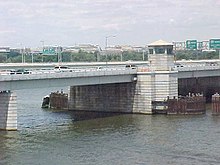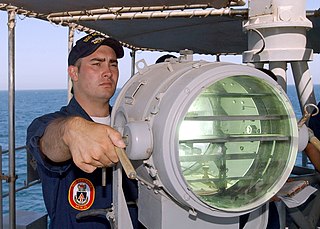
Optical communication, also known as optical telecommunication, is communication at a distance using light to carry information. It can be performed visually or by using electronic devices. The earliest basic forms of optical communication date back several millennia, while the earliest electrical device created to do so was the photophone, invented in 1880.
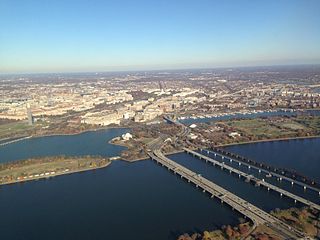
The 14th Street bridges refers to the three bridges near each other that cross the Potomac River, connecting Arlington, Virginia and Washington, D.C. Sometimes the two nearby rail bridges are included as part of the 14th Street bridge complex. A major gateway for automotive, bicycle and rail traffic, the bridge complex is named for 14th Street, which feeds automotive traffic into it on the D.C. end.
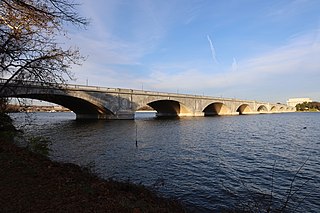
The Arlington Memorial Bridge, often shortened to Memorial Bridge, is a Neoclassical masonry, steel, and stone arch bridge with a central bascule that crosses the Potomac River at Washington, D.C., the capital of the United States. First proposed in 1886, the bridge went unbuilt for decades thanks to political quarrels over whether the bridge should be a memorial, and to whom or what. Traffic problems associated with the dedication of the Tomb of the Unknown Soldier in November 1921 and the desire to build a bridge in time for the bicentennial of the birth of George Washington led to its construction in 1932.
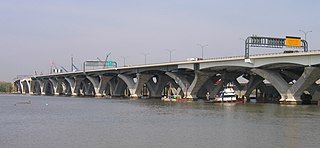
The Woodrow Wilson Memorial Bridge, also known as the Woodrow Wilson Bridge or the Wilson Bridge, is a bascule bridge that spans the Potomac River between Alexandria, Virginia and Oxon Hill, Maryland in Prince George's County, Maryland. The original bridge was one of only a handful of drawbridges in the Interstate Highway System. It contained the only portion of the Interstate System owned and operated by the federal government until construction was completed and it was turned over to the Virginia and Maryland departments of transportation.

Kiewit Corporation is an American privately held construction company based in Omaha, Nebraska founded in 1884. In 2021, it was ranked 243rd on the Fortune 500. Privately held, it is one of the largest construction and engineering organizations in North America. It is an employee-owned company.

Interstate 395 (I-395) in Washington, D.C., and Virginia is a 13.79-mile-long (22.19 km) spur route of I-95 that begins at an interchange with I-95 in Springfield and ends at an interchange with US Route 50 (US 50) in Northwest Washington, D.C. It passes underneath the National Mall near the US Capitol and ends at a junction with US 50 at New York Avenue, roughly one mile (1.6 km) north of the 3rd Street Tunnel. Despite its proximity to I-395 in Maryland, the route is unrelated and unconnected.
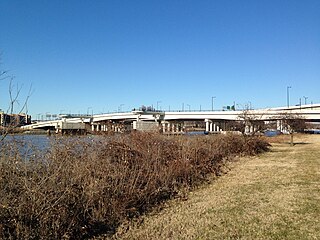
The 11th Street Bridges are a complex of three bridges across the Anacostia River in Washington, D.C., United States. The bridges convey Interstate 695 across the Anacostia to its southern terminus at Interstate 295 and DC 295. The bridges also connect the neighborhood of Anacostia with the rest of the city of Washington.

Light tubes are structures that transmit or distribute natural or artificial light for the purpose of illumination and are examples of optical waveguides.

East Los Streetscapers Public Art Studios is a muralist art collective and fine art studio based in East Los Angeles, California. Its members have executed over twenty murals and large-scale public artworks, primarily in the Los Angeles area.

The Federal Building and U.S. Courthouse, Wheeling, West Virginia is a courthouse of the United States District Court for the Northern District of West Virginia located in the city of Wheeling, West Virginia. Built in 1907, the building still serves its original function, and was renovated and expanded in 1937, and again in 2004. In 1979, it was listed in the National Register of Historic Places in 1979 as a contributing building to the Wheeling Historic District.

The Bridge of Glass is a 500-foot (150 m) pedestrian partially-covered footbridge spanning Interstate 705 in Tacoma, Washington. It was opened in 2002 as a gift to the city. The Bridge of Glass connects the Museum of Glass on the Thea Foss Waterway to the downtown and attractions along Pacific Avenue such as Union Station, Washington State History Museum, and Tacoma Art Museum. Together, these attractions make up an area of Tacoma described as "Museum Row." The Bridge of Glass was designed by Texas architect Arthur Andersson and is decorated with artworks by Dale Chihuly. Chihuly has described the Bridge of Glass as "the gateway that welcomes people to Tacoma." It is accessible and free to the public 24 hours a day, lighting up during the nighttime.
Picture framing glass usually refers to flat glass or acrylic ("plexi") used for framing artwork and for presenting art objects in a display box.
The Village of the Arts is located in Bradenton, Florida. The Village covers 36 acres (150,000 m2) and contains over 200 homes, art galleries, restaurants, workshops and studios. Area residents live alongside the artists. Many galleries/studios in this area are also homes, making this restored section of Bradenton unique with its many artists-in-residence.

The Chelsea Street Bridge is a vertical-lift bridge that carries Chelsea Street between East Boston, Massachusetts, and Chelsea, Massachusetts, over the Chelsea Creek. It opened to traffic on May 12, 2012, after a $125.3M construction project replaced the previous bridge, a single-leaf bascule-type drawbridge. The span is 450 feet (140 m) with a vertical clearance, when opened, of 175 feet (53 m). There are two lanes and a sidewalk in each direction.

The Winant Avenue Bridge is a vehicular movable bridge spanning the Hackensack River in Bergen County, New Jersey 14 miles (23 km) from its mouth at Newark Bay. Built in 1934, it is also known as the Route 46 Hackensack River Bridge and S46 Bridge, it carries U.S. Route 46 (US 46) in Little Ferry and Ridgefield Park. Owned and operated by the New Jersey Department of Transportation (NJDOT), the double leaf bascule bridge is located on a navigable reach. While there have been no requests since 1978, the Code of Federal Regulations last amended in 1999 requires 24-hour notice to be opened. The bridge has been minimally altered since its construction and is eligible for individual listing on the National Register of Historic Places (NRHP).

Steven Weitzman is an American public artist and designer known for his figurative sculptures, murals, and aesthetic designs for highway and bridge infrastructure projects.
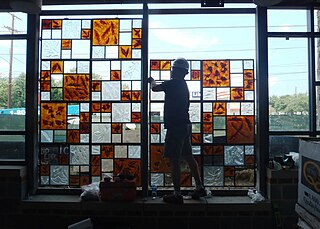
Erwin Timmers is a Dutch-born American artist and the co-founder of the Washington Glass School in the Greater Washington, D.C. capital area. Timmers has been recognized as one of the early "green or environmental artists", working mostly with recycled glass.

Washington, D.C., the capital of the United States, has a unique and diverse architectural history. Encompassing government, monumental, commercial, and residential buildings, D.C. is home to some of the country's most famous and popular structures designed by some of the leading architects of their time. The popularity of the city's buildings is reflected in the findings of a 2007 poll of Americans by the American Institute of Architects, which found that six of the top 10 most popular U.S. structures were located in Washington, D.C. Overall, the poll found, 17 of the top 150 most popular structures were located in the capital.

